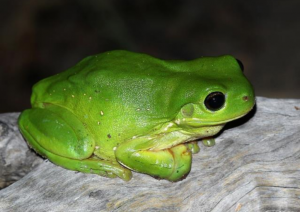The Warrego river is having its best flow in ages. The floodplain is connected to the channel and hundreds of hectares of habitat is being inundated. We can’t get out there to have a look because we are in our homes helping to keep the community safe. But we can guarantee the frogs are having a field day.

Figure 1. Green tree frogs (Litoria caerulea) are one of the many frog species known to thrive in the Warrego floodplain and channels after good flows during the warmer months. We spotted this one in the Warrego during a frog survey for the LTIM Project.
How do we know?
We have spent the last 5 years surveying for frogs as flows have entered the Warrego and we’ve noticed a few striking patterns. One of our favourites is the link between water and frogs. This is called ‘positive association’ and in this scenario, it shows that the Warrego frogs leap forward (sorry) when the system gets wet. We also found that the warmer the season the bigger the leap – in other words – frogs love a wet summer!
We’ve broken this scenario down into its three main stages:
- Increased flow: Good rainfall in the catchment leads to flow in the Warrego and connection through the channels and to the floodplain.
- Connectivity: The connection along the river (longitudinal) and to the floodplain (lateral) links animals with habitat.
- Increased habitat range: The wetted habitat ‘booms’. Nutrients are released, insects thrive, plants grow and larger animals such as frogs take advantage.
These three vital stages contribute to a spike in the availability of things frogs need and love like shelter, food and plenty of space to safely find a mate. Species such as the spotted marsh frog, the barking marsh frog and the green tree frog thrive in response to this resource boost.
How do we know? Well when we get good flows and connection we put on our waders and survey the floodplain and channels for frogs. We do this by walking slowly and quietly at dusk and dawn. We have to be quiet because we are listening for the distinctive croak, ribbit and pobblebonk of each species. If we are lucky, we can see a few too. With a lot of water and warm conditions we count more frog calls than at any other time.
In contrast, we hardly saw or heard a frog during the winter months. Cool and dry conditions reduce the pace of life in the Warrego with frogs being no exception. They find a quiet, safe spot in a remnant pool, a tree hollow, in the mud or even in a park toilet. They wait for the water to return.
What the sciency detail? The Commonwealth Environmental Water Office (CEWO) has you covered: https://www.environment.gov.au/water/cewo

